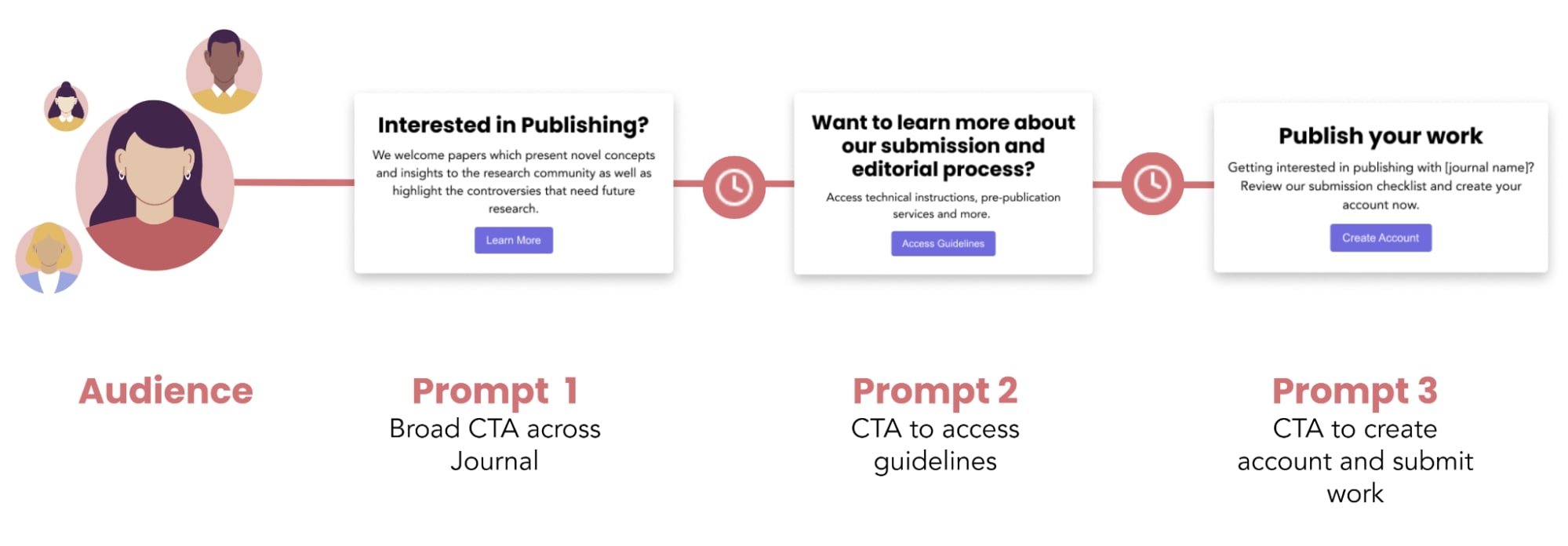In today's digital landscape, single touchpoint interactions with your audience are becoming increasingly insufficient. As publishers and media organizations strive to create deeper connections with readers and drive meaningful conversions, the ability to nurture relationships through multiple, strategic touchpoints has become essential.
With Alchemist Engage, publishers have access to intelligence that translates unified audience data into action: segmentation, journey orchestration, and continuous optimization. Turn audience understanding into orchestrated, multi-touch journeys that deepen relationships and drive measurable outcomes.
Beyond the One-and-Done Approach
Think about your own experience as a content consumer. How often have you immediately subscribed to a newsletter, registered for a webinar, or purchased a membership based on a single prompt?
Most likely, your journey involved multiple touchpoints that gradually built trust and demonstrated value before you committed.
This is the reality of the modern user journey—it's almost never linear!
Multi-stage campaigns represent a fundamental shift in how publishers can engage with their audiences. Rather than relying on isolated interactions, these campaigns create purposeful journeys that guide users toward specific goals through a sequence of meaningful touchpoints.
Here's why strategic nurturing through multiple touchpoints matters for scholarly publishers and B2B media organizations:
1. Meeting Users Where They Are in Their Journey
Different audience segments interact with your content in different ways. Some may be ready to convert immediately, while others need more nurturing. Multi-stage campaigns allow you to introduce your value proposition to first-time visitors, deepen engagement with occasional readers, and drive conversions from your most engaged audience members.
Each stage can be tailored to match the user's relationship with your content, creating more relevant experiences that drive higher conversion rates.
2. Data-Driven Audience Distribution
The most sophisticated multi-stage campaigns don't just sequence interactions—they optimize which specific touchpoints are shown to which users. Alchemist Engage uses machine learning algorithms like multi-armed bandits to automatically distribute your audience across different touchpoint variants to:
- Identify the messaging that resonates best with hyper-targeted segments
- Continuously optimize conversion rates throughout the campaign
- Gather insights that inform future content and marketing strategies
This data-driven approach ensures your campaigns become more effective over time, creating an ongoing cycle of improvement. And once you’ve figured out what’s working well, you can add winning campaign strategies to your template library for future rollout!
3. Creating Cohesive Audience Experiences
When building multi-stage campaigns, think beyond individual touchpoints to the holistic journey you're creating. Each stage should build upon previous interactions while moving the user closer to your ultimate goal.
For example, a scholarly publisher might build a three-stage campaign to nurture relationships with potential authors and generate manuscript submissions.

Explore how OUP is using Alchemist Engage campaigns to deliver messaging about calls for papers to researchers based on specific topical interests.
Media organizations are also leveraging multi-stage campaigns to transform anonymous visitors into known leads, boost premium subscriptions, and increase event registrations through messaging that targets interested potential attendees.
Best Practices for Multi-Stage Campaign Success
What makes a multi-stage campaign successful?
We’ve analyzed campaigns across leading publishers and media organizations, and there are a few key practices that consistently drive results:
- Audience Segmentation Precision Find the sweet spot in your segmentation strategy. Too broad, and your messaging lacks relevance; too narrow, and your reach becomes insignificant. Start with meaningful segments based on content engagement patterns and refine based on performance data.
- Strategic Touchpoint Design Each touchpoint should serve a specific purpose within the larger journey. Use visual diversity across touchpoints to prevent "banner blindness," and ensure messaging evolves logically throughout the campaign.
- Balanced Timing and Frequency Allow sufficient time between stages for users to progress naturally through their decision journey. Too much time creates disconnected experiences; too little feels pushy and diminishes trust.
- Clear, Value-Focused Messaging Every interaction should clearly communicate the value exchange for the user. What will they gain by taking the next step? How does it relate to their goals and interests?
Measuring the Success of Multi-Stage Campaigns
Traditional single-conversion metrics don't fully capture the value of multi-stage campaigns. Instead, consider:
- Journey completion rates: What percentage of users progress through all stages?
- Stage-specific conversion rates: Where do users engage most deeply?
- Engagement velocity: How quickly do users move through the journey?
- Downstream value metrics: How do users acquired through multi-stage campaigns compare in long-term value?
These metrics provide deeper insights into how effectively your campaigns nurture relationships and drive meaningful outcomes.
Multi-stage campaigns represent the next evolution in how publishers connect with their audiences—combining the science of data with the art of storytelling to create experiences that truly resonate.
By meeting users where they are, acknowledging their needs at each stage, and delivering value consistently, publishers can build deeper relationships that drive sustainable growth and engagement in an increasingly competitive landscape.